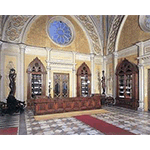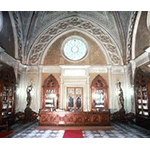Officina Profumo Farmaceutica di Santa Maria Novella [Perfume and Pharmaceutical Works of Santa Maria Novella]
The Perfume and Pharmaceutical Works of Santa Maria Novella is one of the oldest, still operating pharmacies in the world, created during the first half of the 13th century by Dominican friars. The first documentation concerning the production of fragrances and perfumes dates to 1381. The Pharmacy, however, was officially born in 1612, on the suggestion of the Grand Duke of Tuscany. Until 1659, it was directed by Frą Angiolo Marchissi who obtained the privilege of calling the Spicery "Foundry of His Most Serene Highness". In the 18th century, it began exporting its precious products, made on the basis of formulas by the spicer friars, even to India and China. It 1866, its last proprietor Damiano Bensi sold it to his nephew Augusto Stefani, ancestor of the present owners.
The pharmacy conserves the furnishings built in the course of time, intact. The sales room was transformed in 1848 by Domenico Beni, maintaining the Gothic vault of the pre-existent chapel that the Acciaiuoli family donated to the friars in 1335. The room is furnished with shelves in the neo-Gothic style. The frescoes on the walls by Paolino Sarti celebrate the splendour of pharmacies in the world.
The room facing the garden and known as the Sala Verde [Green Room], which was built to connect the new nucleus with the older one, conserves the original furnishings of the mid 18th century, with the walls lined with filoselle silk, the consoles supporting urns, the shelves, the divans and the jars decorated with grotesques. Entering the Sala Verde, on the left wall, one can observe a portrait of Galileo Galilei from the second decade of the 17th century.
The room of the Antica Spezieria [Old Spicery], reserved for sales from 1600 to 1848 and once entered through the door made by Matteo Nigetti, conserves the sober seventeenth-century cabinets with glass panes and shelves, the long sales counter and the stucco decorations on the ceiling with ribbons and festoons very similar to the ones carved above the shelves. The showcases in this room contain several copies of long-stemmed and spiral thermometers of the Accademia del Cimento, the originals of which are in the Museum of the History of Science.
The scientific collections, ranging from the 17th to the early 20th century, exhibited in the sales room, in the Sala Verde and in the Antica Spezieria, embrace three nuclei: pharmacy vessels in ceramic (from the Montelupo, Richard Ginori and Chini manufactories); pharmacy glassware (bottles and vessels from various manufactories); scientific instruments (thermometers, mortars, scales, measuring cups).
Still today, the Perfume and Pharmaceutical Works continues its flourishing production activity in the Mother House of Florence, though many other sales points have been opened throughout the world.
****************************
Texts by Graziano Magrini
English translation by Victor Beard
Last update 10/gen/2008





